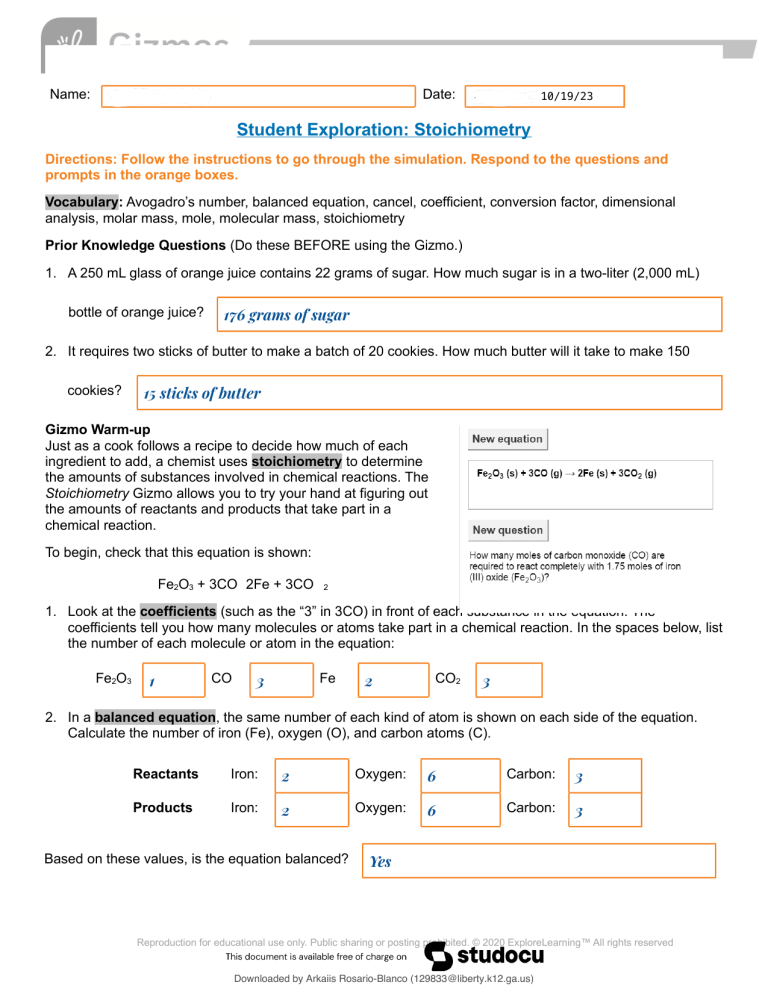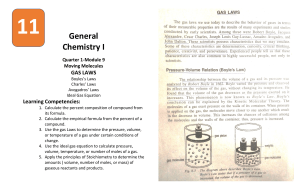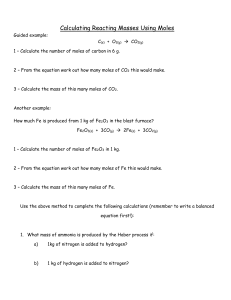
lOMoARcPSD|32192479 Name: Joshua Abbott Date: 1/20/22 10/19/23 Student Exploration: Stoichiometry Directions: Follow the instructions to go through the simulation. Respond to the questions and prompts in the orange boxes. Vocabulary: Avogadro’s number, balanced equation, cancel, coefficient, conversion factor, dimensional analysis, molar mass, mole, molecular mass, stoichiometry Prior Knowledge Questions (Do these BEFORE using the Gizmo.) 1. A 250 mL glass of orange juice contains 22 grams of sugar. How much sugar is in a two-liter (2,000 mL) bottle of orange juice? 176 grams of sugar 2. It requires two sticks of butter to make a batch of 20 cookies. How much butter will it take to make 150 cookies? 15 sticks of butter Gizmo Warm-up Just as a cook follows a recipe to decide how much of each ingredient to add, a chemist uses stoichiometry to determine the amounts of substances involved in chemical reactions. The Stoichiometry Gizmo allows you to try your hand at figuring out the amounts of reactants and products that take part in a chemical reaction. To begin, check that this equation is shown: Fe2O3 + 3CO 2Fe + 3CO 2 1. Look at the coefficients (such as the “3” in 3CO) in front of each substance in the equation. The coefficients tell you how many molecules or atoms take part in a chemical reaction. In the spaces below, list the number of each molecule or atom in the equation: Fe2O3 1 CO 3 Fe 2 CO2 3 2. In a balanced equation, the same number of each kind of atom is shown on each side of the equation. Calculate the number of iron (Fe), oxygen (O), and carbon atoms (C). Reactants Iron: 2 Oxygen: 6 Carbon: 3 Products Iron: 2 Oxygen: 6 Carbon: 3 Based on these values, is the equation balanced? Yes Reproduction for educational use only. Public sharing or posting prohibited. © 2020 ExploreLearning™ All rights reserved Downloaded by Arkaiis Rosario-Blanco (129833@liberty.k12.ga.us) lOMoARcPSD|32192479 Get the Gizmo ready: Activity A: ● Check that the equation is still: Fe2O3 + 3CO 2Fe + 3CO2 Moles ● If not, click New equation until it reappears. Introduction: A mole is: A) B) C) D) E) A mammal known for digging up gardens. A small, dark spot on the skin. A spy embedded within an enemy government. 6.02 × 1023 particles of a substance. All of the above. The correct answer, of course, is E. In chemistry, the mole (mol) is defined as an amount of a substance that contains 6.02 × 1023 particles of that substance. This number, called Avogadro’s number, is special because this number of particles has a mass in grams that is equal to the mass in universal mass units of a single particle of the substance. Question: How do scientists find the molecular mass and molar mass of a substance? 1. Calculate: The molecular mass of a molecule is the sum of the masses of each atom in the molecule. The unit of molecular mass is the universal mass unit (u). Iron’s atomic mass is 55.85 u, carbon’s mass is 12.01 u, and oxygen’s mass is 16.00 u. A. Calculate the molecular mass of carbon monoxide (CO) by adding the atomic mass of carbon and the atomic mass of oxygen: 28.01g B. Calculate the molecular mass of carbon dioxide (CO2): 44.01g C. Calculate the molecular mass of iron (III) oxide (Fe2O3): 159.7g 2. Infer: A mole of a substance has a mass in grams that is equal to the molecular mass. For example, a carbon atom has a mass of 12.01 u. A mole of carbon has a mass of 12.01 g. Based on their molecular masses, list the molar mass of each substance: Fe2O3 159.7g 28.01g CO Fe 55.85g CO2 44.01g Check your answers on the Gizmo by inspecting the middle row of tiles on the right side of the Gizmo. These tiles show the units “1 mol” on top and “g” below. 3. Practice: Hydrogen has an atomic mass of 1.01 u. What is the molar mass of these substances? H2O Activity B: Canceling units 18.02g CH4 16.05g H2CO3 62.03g C6H12O6 180.18g Get the Gizmo ready: ● Check that the equation is still: Fe2O3 + 3CO 2Fe + 3CO2 Reproduction for educational use only. Public sharing or posting prohibited. © 2020 ExploreLearning™ All rights reserved Downloaded by Arkaiis Rosario-Blanco (129833@liberty.k12.ga.us) lOMoARcPSD|32192479 Introduction: While solving problems in stoichiometry, it is useful to pay attention to the units of the answer. The process of comparing units is called dimensional analysis. A common technique involves using conversion factors to convert from one unit to another. Units that appear in the numerator and denominator of a fraction can be canceled out. For example, converting 2 moles of carbon monoxide to grams involves multiplying by a conversion factor: 2 mol CO • 28.01 g CO = 56.02 g CO 1 mol CO All conversion factors are equivalent to one. For example, the conversion factor given above is equivalent to one because the numerator (28.01 g CO) and denominator (1 mol CO) represent the same amount of CO. The “mol CO” unit is canceled, leaving an answer unit of grams. Question: How do we solve problems in stoichiometry? 1. Observe: The first question is: “How many moles of carbon monoxide (CO) are required to react completely with 1.75 moles of iron (III) oxide (Fe2O3)?” (If this is not the question you see, click New question until it appears.) A. What unit is given in the question? Moles B. What quantity is asked for? Moles 2. Find: Look for the conversion factor that contains the units “mol Fe2O3” on top and “mol CO” on the bottom. Drag the tile containing this factor down to the green strip at the bottom. According to the tile, how many moles of CO react with one mole of Fe2O3? 3 moles 3. Analyze: To get an answer in moles of CO, you need to cancel the moles of Fe2O3. Turn on Show units. A. What units are given to the right of the equals sign? B. moles If these aren’t the units you want, click Flip tile. What unit is given now? moles 4. Calculate: If the units are correct, multiply or divide the numbers to solve the problem. A. How many moles of CO will react with 1.75 moles of Fe2O3? 5.25 moles B. Turn on Show numerical result. Were you correct? Yes 5. Practice: Turn off Show units and Show numerical result. Click New question, and use what you’ve learned to solve another stoichiometry problem. For each problem, list the units given, the units asked for, Reproduction for educational use only. Public sharing or posting prohibited. © 2020 ExploreLearning™ All rights reserved Downloaded by Arkaiis Rosario-Blanco (129833@liberty.k12.ga.us) lOMoARcPSD|32192479 and the solution. The problems in the Gizmo are given in random order, so you may have to click Next question several times to see a new problem. (Note: Each term in the equation is either a solid (s), liquid (l), gas (g), or an aqueous solution (aq).) If you are stuck, try one of the following hints: ● If the given unit is grams (or liters or particles), convert from that unit to moles first. Then convert to moles of the answer substance. ● If the answer unit is grams, liters, or particles, find the number of moles of the answer substance first. Then convert the moles of answer substance to the desired unit. ● If you have a calculator, try to calculate the solution to each problem yourself before turning on the Show numerical solution checkbox. Problems: A. What volume of carbon dioxide (CO2) will be produced if 2.90 moles of iron (Fe) is produced? [Note: In the Gizmo, it is assumed that all gases are at standard temperature and pressure, or STP.] Given unit: moles Answer unit: volume Solution: 97.44L CO2 B. What mass of iron (Fe) can be obtained from 3.80 g iron (III) oxide (Fe2O3) reacting with excess carbon monoxide (CO)? Given unit: grams Answer unit: grams Solution: 2.66Fe C. How many moles of iron (Fe) will be produced from 6.20 moles of carbon monoxide (CO) reacting with excess iron (III) oxide (Fe2O3)? Given unit: moles Answer unit: moles Solution: 4.113mol Fe D. How many molecules of carbon monoxide (CO) are needed to react with excess iron (III) oxide (Fe2O3) to produce 11.6 g of iron (Fe)? Given unit: grams Answer unit: molecules Solution: 1.88x10^ 2 3 6. On your own: Click New equation to try solving problems with a new chemical equation. There are five equations in all, and five problems per equation. The Gizmo will keep track of how many problems you solve. Good luck! Reproduction for educational use only. Public sharing or posting prohibited. © 2020 ExploreLearning™ All rights reserved Downloaded by Arkaiis Rosario-Blanco (129833@liberty.k12.ga.us)



